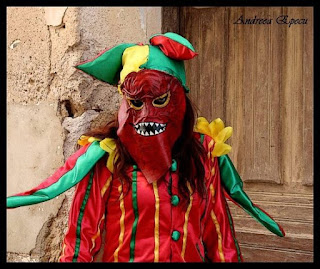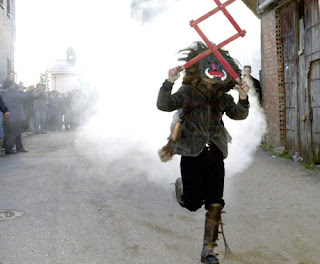Preparing for the Research Residency - Old European Traditions of Clown-Tricksters
One of our sources was the many traditions across Europe that use mask, costume, story, event, character and symbol in communal celebrations and festivities. These include carnival, seasonal changes, saints' days and more. For the three researchers, these traditions are sometimes familiar, sometimes not, sometimes embedded in our cultures in forgotten places. We also are able to see parallels on other continents, but prefer not to speculate as outsiders beyond this acknowledgement.
Many of these traditions involve some kind of clown-like figure, often in the mode of trickster and frequently in the role of devils. As clowns, these are the most interesting to us. We wanted to make these kinds of clowns one of our starting points, rather than the kind of clown we had mostly been formally trained in, which comes from the very recent lineage of theatre clown training in studios, from Lecoq, through Gaulier, with many contemporary clown teachers reproducing the assumptions of what clowns are and how the genre is learned over the past half century.
Crucially, we wanted to set aside the practice of 'vulnerabilising', involving the power dynamic of authoritarian clown teacher and flopping/vulnerable/failing clown student (regardless of whether this is carried out playfully or brutally). This dominant orthodoxy in clowning seemed to us to be a limiting force on the possibilities of clowning, acting to exclude many (perhaps those who live 'vulnerability' as reality), and to keep clowning within the polite confines of the art-theatre with its clear demarcation between actors and audience.
In its place, we wanted to explore the potential for the old European trickster clowns as energetic, celebratory, joyous and recognisable figures, who can cross lines, break rules and sometimes be wild and destructive. Could these figures and their acts, events, costumes and stories be used to disturb, re-imagine and challenge the way we organise our societies and our relationships? In particular, in public spaces?
These, then, were our three threads of interest as we came into the project:
1.
Clowning in outdoor spaces
2.
Pre-theatrical forms of clowns and tricksters
across Europe and beyond
3.
Political activism and our desire for increased
awareness, change and social justice
Because of my ow personal history, many of my reference points were from fiestas in Spain, including Cipotegato (Tarazona), the Bobo (Basque country/Navarra), the Carochos (Riofrío de Aliste), the Endiabladas (Almonacid del Marquesado) and the Colachos (Murcia de Burgos).
See this playlist
Plus some images follow
Jon Davison





















Comments
Post a Comment